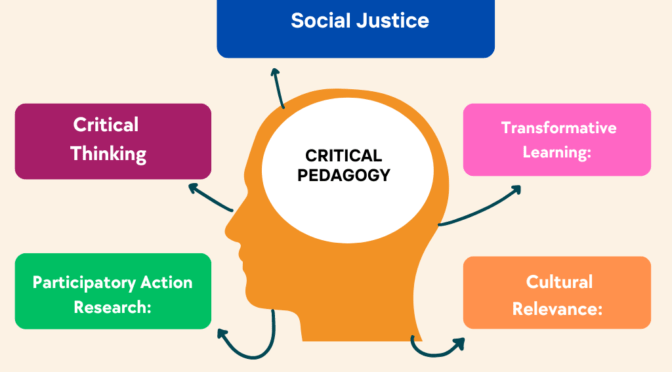
Introduction to Critical Pedagogy
Education is not just about transferring knowledge; it’s a powerful tool for social change. Critical pedagogy challenges traditional teaching methods and encourages educators to rethink their roles. This approach goes beyond textbooks, diving into the complexities of power, identity, and justice within learning environments.
In an era where social issues are at the forefront of our collective consciousness, understanding critical pedagogy is essential. It invites us to question norms and empower students to become active participants in their education. By fostering critical thinking skills and promoting awareness of societal injustices, we pave the way for a more equitable future.
So what exactly is critical pedagogy? How did it evolve over time? In this blog post, we’ll explore its history, key principles, real-life applications, criticisms faced by this educational philosophy, and ultimately its profound impact on education today. Get ready to see how embracing these ideas can lead us toward a more just society through transformative learning experiences!

The History and Development of Critical Pedagogy
Critical pedagogy has roots that stretch back to the late 20th century. It emerged as a response to traditional educational models, which often prioritized rote memorization over critical thinking and social awareness.
Pioneered by thinkers like Paulo Freire, this approach sought to empower marginalized voices in education. Freire’s seminal work, “Pedagogy of the Oppressed,” laid the foundation for understanding how education can both reflect and challenge societal structures.
As globalization intensified, so did discussions around equity and justice in educational settings. Scholars began weaving together various influences, including Marxism and feminist theory, enriching critical pedagogy with diverse perspectives.
Throughout its evolution, advocates have focused on creating spaces where learners engage actively with material. This dynamic fosters not only academic growth but also promotes civic responsibility among students. The ongoing dialogue surrounding its principles continues to shape modern educational practices today.
Key Principles and Concepts of Critical Pedagogy
Critical pedagogy is built on several foundational principles that challenge traditional views of education.
At its core, it emphasizes dialogue over monologue. Students and educators engage in conversations where both voices are valued equally. This interaction fosters critical thinking and empowers learners to articulate their perspectives.
Another key concept is the focus on social justice. Education becomes a platform for examining power dynamics within society, encouraging students to question inequalities they observe around them.
Contextual learning plays a significant role too—knowledge isn’t isolated but connected to real-world issues relevant to students’ lives. This approach makes learning meaningful and applicable.
Additionally, critical pedagogy advocates for reflexivity among educators. Teachers must continuously examine their own beliefs and biases while adapting teaching methods accordingly.
These principles create an educational environment that not only educates but also inspires action toward societal change.
The Role of the Educator in Critical Pedagogy
Educators play a vital role in the framework of critical pedagogy. They aren’t just transmitters of knowledge; they act as facilitators and guides. Their primary focus is to create an environment where students feel empowered to question societal norms.
In this approach, teachers encourage dialogue and collaboration among students. This helps cultivate critical thinking skills essential for social justice advocacy.
Moreover, educators must reflect on their own biases and assumptions. By doing so, they model lifelong learning for their students.
The relationship between educator and student becomes a partnership in discovery rather than a traditional top-down hierarchy. This shift fosters deeper engagement with content, encouraging learners to connect personal experiences with broader social issues.
Through this transformative process, educators can inspire change-makers who advocate for equity and challenge oppressive systems within education and beyond.
Real-Life Applications and Examples of Critical Pedagogy
Critical pedagogy isn’t just theory; it comes alive in classrooms around the globe. Teachers utilize dialogue and reflection to create spaces where students can express their identities and challenge societal norms.
In many urban schools, educators implement community-based projects that encourage students to engage with local issues. This not only empowers learners but also fosters a sense of responsibility toward their communities.
Art is another powerful medium for critical pedagogy. Students might use visual storytelling or performance art to explore themes like social justice or inequality, sparking meaningful conversations among peers.
Universities also embrace these principles through service-learning courses that connect academic content with real-world challenges. This hands-on approach nurtures critical thinking while promoting civic engagement and activism among college students.
Each application demonstrates how education can serve as a catalyst for change, driving home the importance of addressing social issues within learning environments.
Criticisms and Controversies Surrounding Critical Pedagogy
Critical pedagogy has faced its share of criticisms. Detractors argue that it leans too heavily on ideology, potentially sidelining essential content knowledge. They fear this focus might compromise academic rigor.
Some educators claim that the approach can be overly prescriptive. They believe it may restrict teachers’ creativity in the classroom by enforcing specific political or social agendas.
Moreover, opponents question the practicality of implementing critical pedagogy in diverse educational settings. Not all students are ready to engage with challenging concepts around power dynamics and social justice.
Critics also highlight potential polarization among students. Engaging discussions about contentious issues can sometimes lead to division rather than unity within classrooms.
These controversies spark ongoing debates about how best to foster an inclusive environment while addressing systemic inequalities through education.

The Impact of Using a Critical Pedagogical Approach in Education
A critical pedagogical approach transforms classrooms into vibrant spaces of inquiry and dialogue. It encourages students to question societal norms and power dynamics, fostering a sense of agency.
When learners engage critically with content, they connect their personal experiences to broader social issues. This connection cultivates empathy and promotes social justice awareness among students.
Educators become facilitators rather than mere transmitters of knowledge. They guide discussions that challenge traditional narratives, empowering students to express their views confidently.
The impact extends beyond individual growth; it ripples through communities. Students equipped with critical thinking skills often advocate for change in their surroundings, pushing for equity in various spheres of life.
This paradigm shift not only enriches the educational experience but also lays a foundation for active citizenship—where informed individuals contribute positively to society’s evolution.
Conclusion: Why Critical Pedagogy Matters for
Critical pedagogy is not just an educational approach; it’s a transformative movement. It prioritizes social justice and empowers both educators and learners to challenge oppressive systems. By fostering critical thinking, dialogue, and collaboration, this pedagogical framework encourages students to become active participants in their own education.
The impact of critical pedagogy extends beyond the classroom. It cultivates informed citizens who are aware of societal issues and motivated to enact change. As we navigate complex global challenges, the principles of critical pedagogy remind us that education can be a powerful tool for social transformation.
Embracing this approach means recognizing the importance of context in learning experiences. Educators must strive to create inclusive environments where diverse voices are heard and valued. This commitment to equity enriches learning outcomes while nurturing empathy among future generations.
The relevance of critical pedagogy lies in its ability to inspire action toward a more just society. The world needs individuals equipped with the skills and mindset necessary for questioning norms and advocating for systemic change. Hence, integrating these principles into our educational practices is essential for shaping a better future rooted in justice and equality.



Leave a Reply